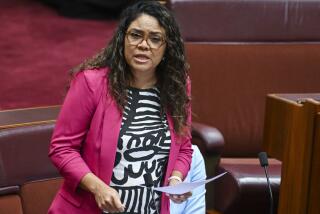Speaking Of: : Australian Aborigines
Life has been an uphill battle for Australia’s original inhabitants since 1788, when the British began settling the continent. Like Native Americans, Aborigines soon became second-class citizens, losing their land to European settlers. They were only given the vote in 1962.
Today, there are more than 265,000 Aborigines and Torres Strait Islanders, about 1.6% of Australia’s population--fewer than in 1788 but growing. Many own or control land under various arrangements. In 1990, the Australian government formed a special commission of elected Aborigines and Torres Strait Islanders to direct policies that affect them.
While the government has programs to improve their health, education, job skills and living conditions, the Aborigines still fare worse than Australians as a whole by many key measures.
GROWING POPULATION
Before the arrival of the British, there were an estimated 300,000 Aborigines. By 1900, ravaged by foreign diseases, alcohol, starvation and extermination, they had been reduced to 25% of that number.
During World War II, however, the trend began reversing as the government worked to improve nutrition and medical care. Today, most of the people who classify themselves as Aborigines are of mixed origin. As a group they tend to be much younger than their Australian compatriots and have a shorter life expectancy.
* Aborigines and Torres Strait Islanders
0-19 yrs.: 51%
20-39: 32%
40-59: 13%
60 and over: 4% * All Australians
0-19 yrs.: 30%
20-29: 32%
40-59: 22%
60 and over: 16%
(Source: Austrailan Census of Population and Housing, 1991)
LIFE EXPECTANCY * Aborigines and Torres Strait Islanders
Men: 54
Women: 63 * All Australians
Men: 72
Women: 78 (Source: Austrailan Census of Population and Housing, 1991)
UNEMPLOYMENT RATE * Aborigines and Torres Strait Islanders: 31% * All Australians: 11% (Source: Australian Census of Population and Housing, 1991)
RURAL VS. URBAN
Before World War II, Aborigines were segregated from society on government reserves and missions. Later, Aborigines were evacuated from some of the missions and into the traditionally white work force. They continue to migrate to urban areas for better jobs. Still, numerous “outstations”--similar to American Indian reservations--have been settled by groups of Aborigines following mainly traditional ways.
* Aborigines and Torres Straits Islanders
Percent living in cities of 100,000 or more: 24.4
Percent living in towns and cities of 1,000 to 99,999: 42.1
Rural areas: 33.5 * All Australians
Percent living in cities of 100,000 or more: 62.9
Percent living in towns and cities of 1,000 to 99,999: 22.4
Rural areas: 14.6
(Source: Year Book Australia 1991)
WHERE THEY LIVE
Number of Aborigines and their percentages of each state’s population. New South Wales: 59,011 (1.1%) Australian Capital Territory: 1,220 (0.5%) Victoria: 12,611 (0.3%) Queensland: 61,268 (2.4%) South Australia: 14,291 (1.1%) Western Australia: 37,789 (2.7%) Tasmania: 6,716 (1.5%) Northern Territory: 34,739 (22.4%) (Source: Australian Census of Population and Housing, 1986)
LAND RIGHTS
When the British first arrived, Aborigines, using guerrilla tactics, fought unsuccessfully to hold their land. It wasn’t until this century, and particularly in the 1960s, that they began to recover some land through strikes, protests and court action.
By 1988 a number of Aboriginal communities had some form of title to 8% of Australia’s land--mostly in barren areas of the Northern Territory and South Australia. They hold it in trust, or freehold, either for life or with the right to pass it on through inheritance.
They also occupy nearly 5% more of Australia either through leaseholds or in the form of reserves or missions set aside for them. (Source: Year Book Australia 1991)
EDUCATION
Until World War II Aborigines were excluded from state education systems. Today, almost every Aborginal child is within reach of a school, but there is still unofficial segregation. Poverty and social problems outside the classroom also handicap the performance of Aboriginal school children. * Aborigines and Torres Strait Islanders
University Degree: 1.8%
Associate Diploma: 0.5%
Vocational Certificate: 5.4%
Total: 7.7%
No University Degree or Certificate: 79.7%
Inadequately Described/Not Stated: 12.6% * All Australians
University Degree: 12.0%
Associate Diploma: 1.0%
Vocational Certificate: 13.0%
Total: 26.0%
No University Degree or Certificate: 61.0%
Inadequately Described/Not Stated: 13.0% (Source: Australian Census of Population and Housing, 1991)
OTHER SOURCES: The Concise Encyclopedia of Australia; But Now We Want the Land Back Compiled by Times researcher ANN GRIFFITH
More to Read
Sign up for Essential California
The most important California stories and recommendations in your inbox every morning.
You may occasionally receive promotional content from the Los Angeles Times.








